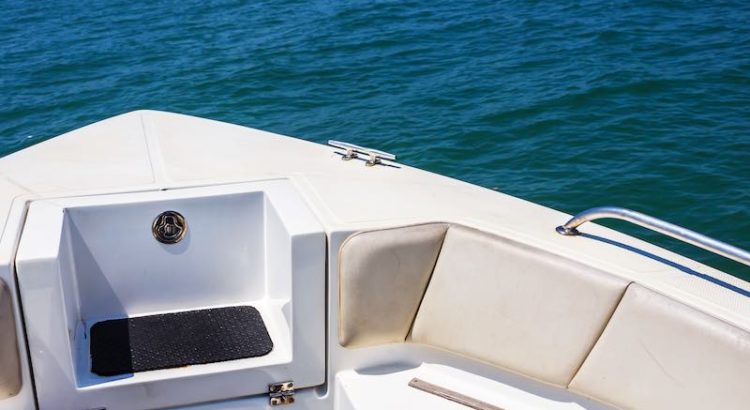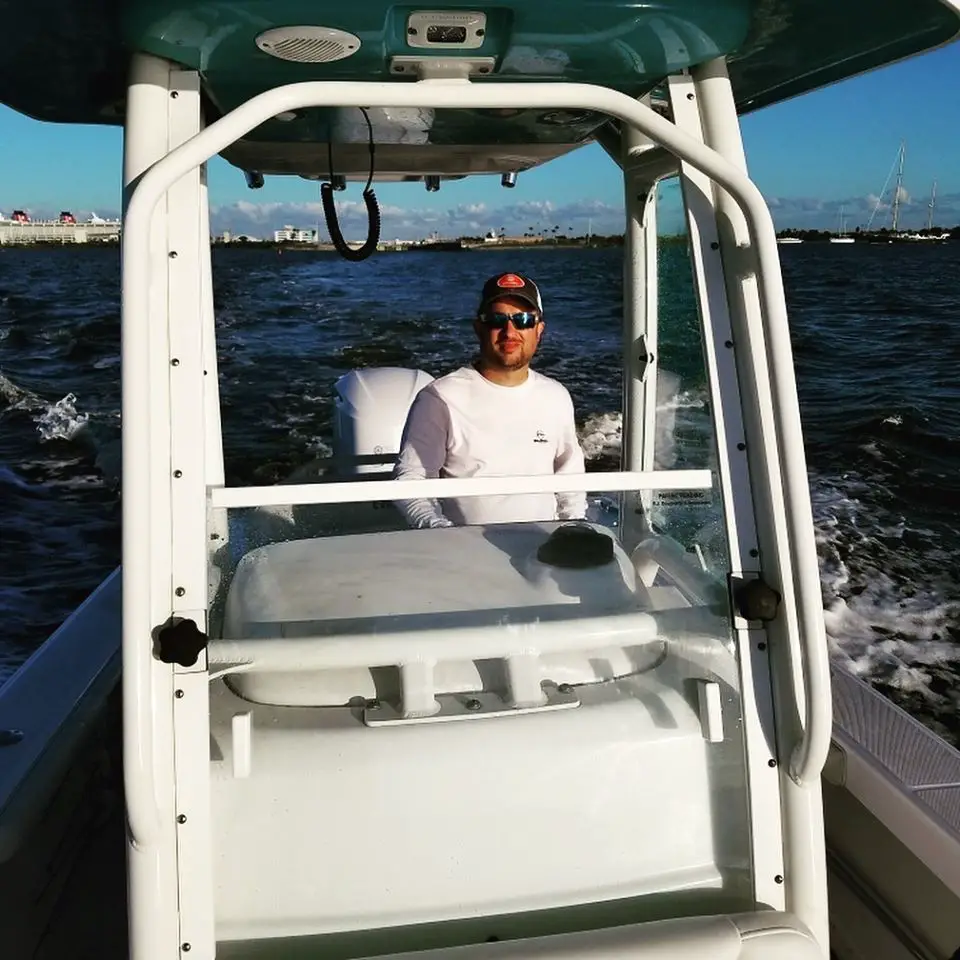This page contains affiliate links. This means that we may get a small commission for recommending products, if you choose to click on something and buy it. This does not cost you anything, but we wanted to be honest and let you know!
(Last Updated On: )Table of Contents
How Important Marine Upholstery Really Is?
One of the most appealing parts of your boat is the boat upholstery. The look of a boat’s interior has a significant impact on the appearance of your boat overall.
The fabric on boat seats determines if your time on the water is spent in comfort or if you spend it on cracked, flaking material that is scratchy and can cause cuts.
If you are considering purchasing a new boat, a used boat, or even doing a re-upholstery job yourself, you must know about the material that makes the best boat upholstery.
Types of Upholstery
Leather Upholstery
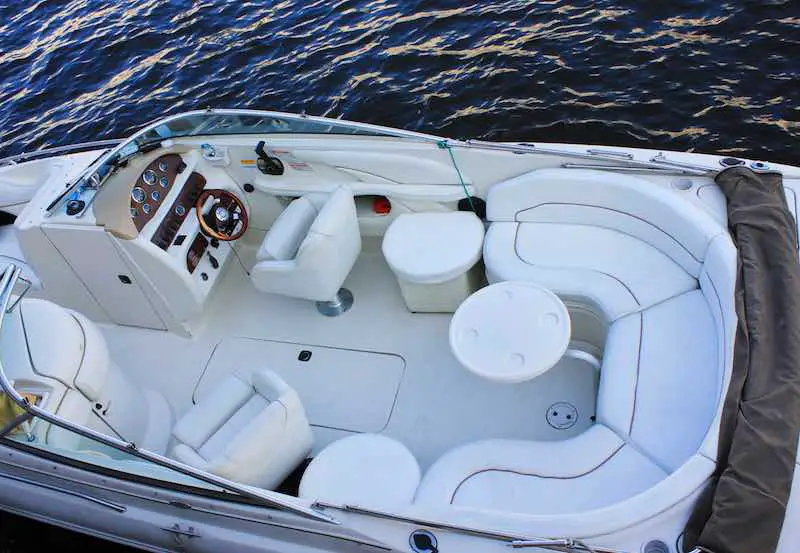
You might wonder about the use of leather on boat seats.
Many products that we use every day, including clothing, furniture, and car seats, use leather extensively.
Leather is not used often in marine applications. When leather is exposed to water, it is easily damaged.
Direct sunlight causes the exposed leather to dry out and crack.
There are products that, when applied to leather, will make it more weather resistant. However, the process to do so is both time-consuming and expensive.
To prevent overdrying, leather upholstery needs to be cleaned with a neutral soap, or with a cleanser that has a pH balance of seven every week.
The leather needs to be spayed with a leather conditioner that contains a UV protectant every week to keep the leather soft and pliable.
Even in the area of the boat that offers more protection, such as the cabin, genuine leather is rarely used because of the difficulty maintaining leather exposed to the environment.
You really don’t want to spend the time maintaining that type of material, or the money it would cost for leather boat seats. Especially for a product that will fail in the end.
The fabric for marine upholstery needs to be durable and low maintenance.
The material also needs to be waterproof. Leather is only waterproof when it is still on the cow.
So stay away from leather for use on a boat as it will cost more, will not be long-lasting, require lots of frequent maintenance, and becomes unsightly in a short length of time.
Canvas Upholstery
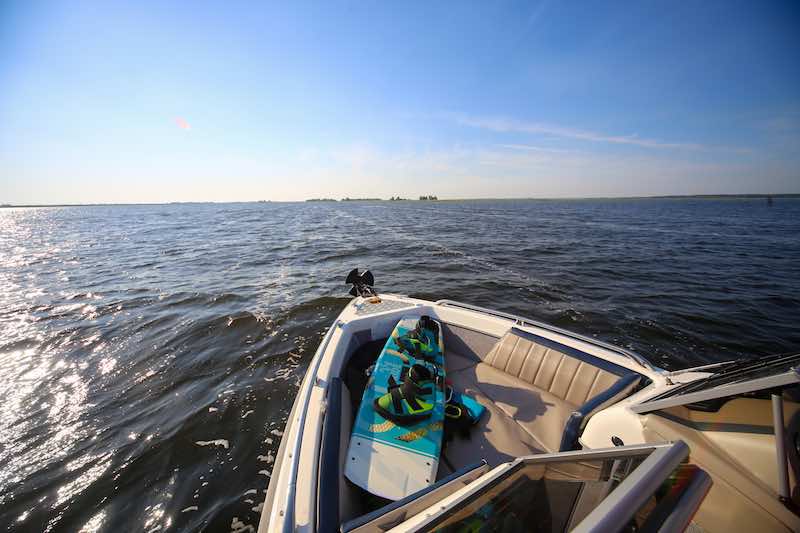
A material that is commonly used for marine applications is the canvas. Canvas has strength and is very durable.
It is used for protective covers for boats and cars.
An advantage of canvas for marine use is that the fabric can breathe. It tends to stay cooler in the sun while continuing to maintain its durability.
Reasonably priced, canvas comes in a wide variety of colors and styles.
Vinyl Upholstery
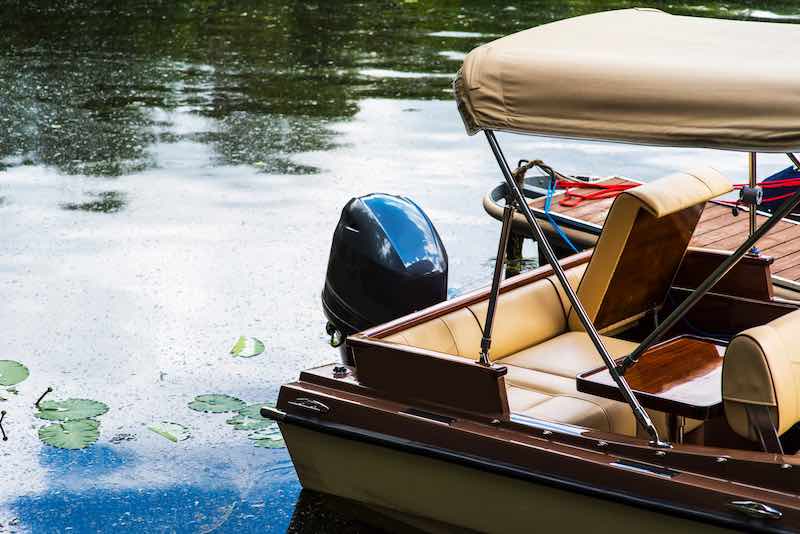
The vast majority of boat furniture and the padded interior side panels on a boat are covered with marine-grade vinyl.
This marine fabric is wonderfully durable and will stand up to all kinds of weather.
Made from PVC Vinyl and polyester, the marine-grade fabric is antifungal, essential to a vessel that will spend most of the time in the water.
The fabric is also treated to be mildew-resistant, fire retardant, and is treated to withstand UV rays.
All of these qualities made marine-grade vinyl ideal for boat cushions, boat chairs, and any other outdoor items that need heavy-duty upholstery.
Vinyl is made from a series of processing steps that convert raw materials (petroleum, natural gas, or coal) into synthetics called polymers.
It seems appropriate that marine-grade vinyl is used extensively in the boating industry.
If you simplify the process to the very basics, vinyl is a concoction of petroleum and seawater.
When these two are processed and combined, they make Polyvinyl Chloride or PVC.
PVC is incredibly popular for all types of everyday items, and the boating industry has made good use of this incredible material.
Just know that it must be marine-grade vinyl that is used on boat furniture, not standard vinyl.
Most boats built will have marine-grade vinyl for the captain’s chairs and deck seats, so if you are buying new from a reputable manufacturer, it won’t be a consideration.
However, if you are buying a used boat, double-check the grade of material that is on the boat furniture.
If you are looking to refurbish any boat furniture yourself, get the marine grade of vinyl.
This brief video compares marine and standard vinyl: Comparing Marine Vinyl & Standard Vinyl
Waterproof vs. Water-Resistant Marine Upholstery
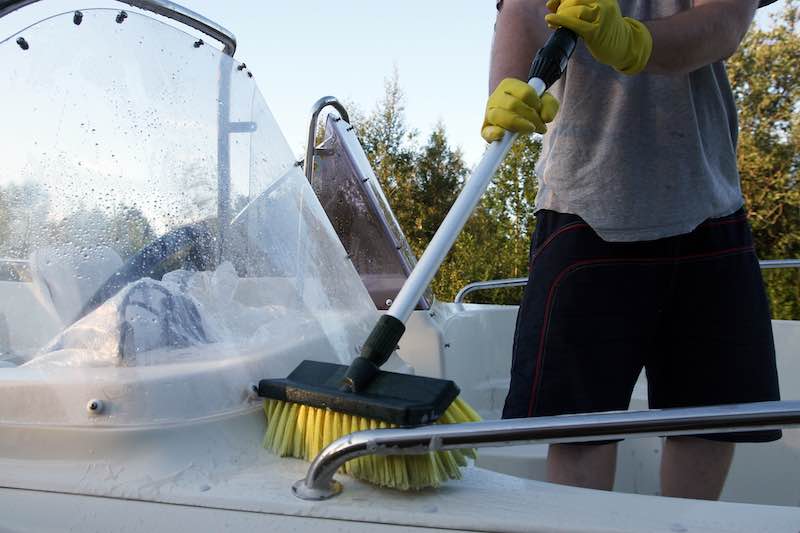
I had always thought that waterproof and water resistance were virtually the same thing. I have since learned that they are not.
When it comes to boat upholstery, there is a big difference.
According to the dictionary definition, waterproof means that an item is “impervious to water.”
Water-resistant means that the item is “designed to not be easily affected by water or to not allow water to pass through easily.”
Knowing the difference between the two terms enables you to see that it would make a big difference in choosing materials for boat cushions.
It also impacts the kind of material maintenance that will be needed to preserve and maintain the boat chairs.
Per the definition, water-resistant fabrics are not ideal for boat furniture. You would want the material on the chairs and seat of a boat to be waterproof.
The interior of a boat’s furniture is almost always a foam form. If moisture (a given on a boat) works its way to the foam interior, it will result in mold and hasten the deterioration of any material covering the form.
Advantages of Marine Grade Vinyl
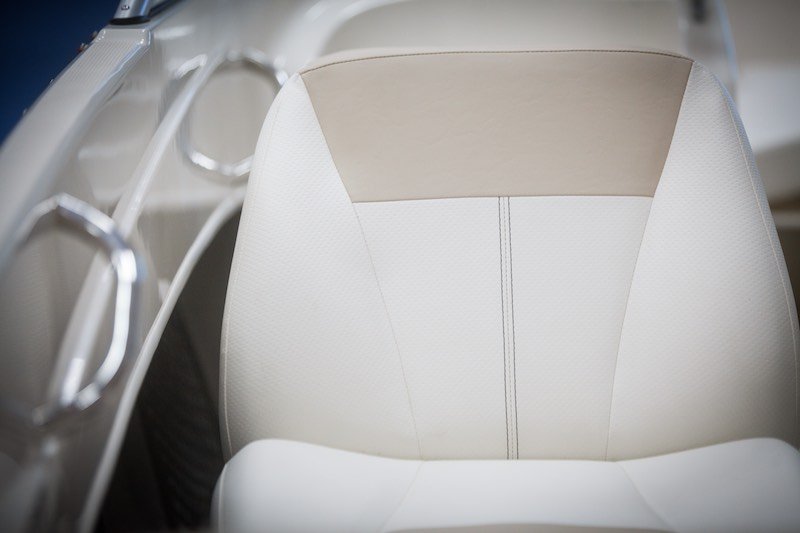
The most significant endorsement for marine-grade vinyl is that boat manufacturers use this material almost exclusively for the furniture on a boat.
I always like it when you are trying to make a decision, and there is a clear winner.
We wrote earlier about some of the advantages of marine vinyl. Here are some additional benefits to the material.
- It is flexible
- It can be sewn or glued or stapled
- It is inexpensive
- It can withstand the elements
- It comes in numerous colors
- It comes in different textures
- Maintenance is relatively easy and can be done by the owner
- Replacement or repairs can be done by the owner
- Has a longer lifespan than other materials
How to Care for Boat Furniture
As with any other investment, you want to keep your boat looking good for years to come.
It doesn’t matter if you bought it brand new or got it on the cheap from Craigslist, you want to keep your boat looking its best.
When you, or your guests, sit or move around on the boat furniture, the dirt, and oils that are on the surface of the material act just like sandpaper.
The dirt wears down the surface of the vinyl and makes the material vulnerable to fading, staining, and cracking.
One of the best ways to keep the vinyl in your boat looking good is to keep it clean. After each outing, walk around the boat and check the surfaces.
Try not to let spills from food or drink sit on the surface, but wipe them up when you see them.
That goes for water, too, whether it be saltwater or fresh. Don’t let water sit in a pool on the furniture; wipe it dry.
If possible, check with the manufacturer to see how they advise cleaning the vinyl. If that is not possible, follow the suggestions below.
Periodically wash down the surfaces of your boat furniture every few weeks when not in use.
Use a soft cloth or sponge with a mild soap (not detergent) and warm water.
Use fresh water, not water from the lake or river. Both of those waters contain impurities and particles that will act as abrasives on the vinyl.
A small brush can serve to help scrub areas that need particular attention. Rinse the cleaned surfaces off with fresh water and dry with a soft cloth.
Do not use harsh chemicals on the vinyl that can damage the surface.
Stay away from bleach or products with bleach. Bleach deteriorates both the stitching and the fabric.
Popular products like Magic Eraser will work great, getting rid of stains but will damage the vinyl.
Magic Eraser is an abrasive, and any abrasive product will damage the surface of the vinyl.
As stated before, do not use bleach on vinyl. Avoid ammonia, dry cleaning fluids, solvents, or concentrated detergents.
Marine vinyl has been treated to render it waterproof, UV protected, and antifungal. Using harsh chemicals could remove that protection.
Another way to protect your boat furniture is to have a cover for your boat. While you are using a cover to keep out the elements, you don’t want to trap moist air inside.
Some covers come with vents that allow air to pass through and provide ventilation.
If your cover does not have these vents, you can purchase and install them yourself.
These vents also provide an exit for air when you are transporting your boat on a boat trailer.
Vents can keep the cover from filling with air and flying off while you are traveling down the expressway.
Never Would Have Guessed It
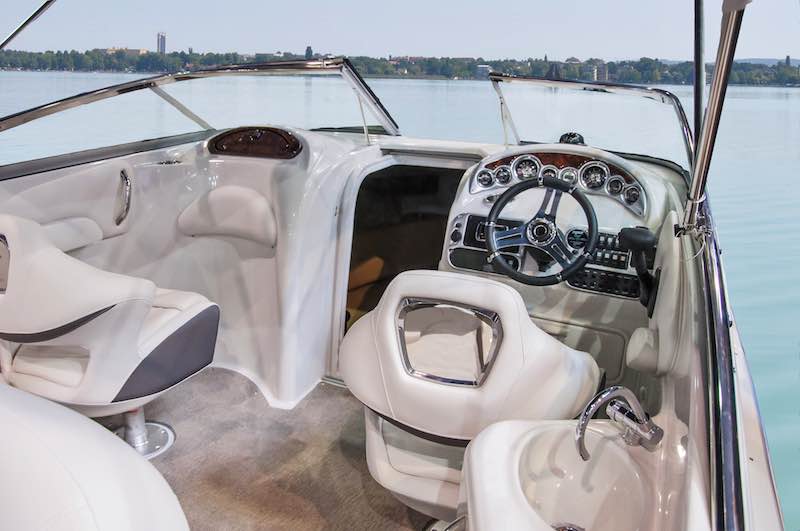
Guess what the number one cause of damage to vinyl boat seats is. Nope. It is not beer. I would never have gotten this one right…it is tree sap.
We all know how sticky tree sap is and how hard it is to get it off your own skin.
On vinyl that sits in the sun or is exposed to the hot weather, tree sap melts into the vinyl and is almost impossible to get off.
As the saying goes, an ounce of prevention is worth a pound of cure. Keep your boat covered when you are not using it.
That will keep the sap from getting on the seats in the first place.
If you do get tree sap on the vinyl material get it off as soon as possible. Use a citrus-based cleaner that does not contain bleach.
Even then, it will be a hard go to get the sap off. Again, if you are going to be parked under trees, put a cover over the boat.
Mold, Mildew and Boat Upholstery
One of the unfortunate hazards for anything that is primarily used in and around water is that mold and mildew can result.
It is virtually impossible to keep surfaces dry. Water is going to come from wet guests, the spray of water from the lake, or the humidity in the air.
If you follow the suggestions we outlined above about keeping your boat furniture clean, it will go a long way to helping prevent mold and mildew.
Inevitably, some mildew will occur. It is just the nature of the beast. When it does happen, act fast to stop its spread.
In this handy video, they have already made comparisons of cleaners for mildew on marine vinyl. I love it when someone has done all the hard work and graciously shows us their results.
Here is the video for Comparisons of Cleaning Products for Mildew
Do It Yourself
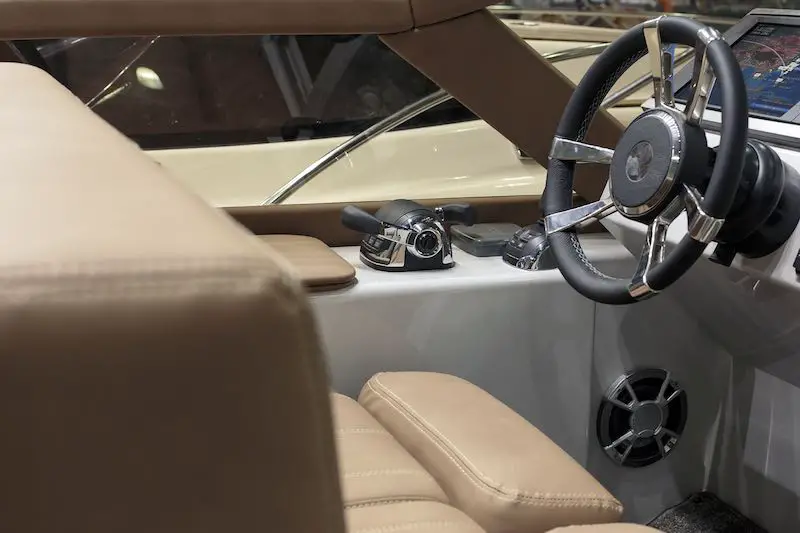
Let’s say that you went to a local car and boat auction like a friend of mine did.
And let’s say that you were able to purchase a pontoon boat (although you had to buy it sight unseen as it was encased in plastic wrap) for a mere $1,500, including the motor!
When you get it home, you are delighted to find that with a minimum amount of work, the motor runs, the deck is solid, and the water is waiting.
The small downside was that the vinyl on the side benches was a bit rugged.
It seems like the previous owner did not adhere to our helpful suggestions on caring for their boat furniture.
But not to despair! If you are brave enough to buy a pontoon sight unseen, you are brave enough to tackle reupholstering the benches yourself!
First Things First
Being a smart cookie, the very first thing to do is to take pictures of the old material while it is still in place.
Take it from different angles before you remove it from the boat. This will give you points of reference and comparison.
Once you have chosen the material (marine-grade vinyl, remember?) that you would like (we have a suggestion chart below), make sure to follow the prep directions from the manufacturer.
You will most likely need to spread the fabric out to avoid fold marks. Give the fabric time to relax before installing it.
If you don’t already have them, you will most likely need seam removers (for the stitching), silk film (this is explained later), a screwdriver, a staple remover, stapler, stainless steel staples and spray adhesive.
Depending on how elaborate you get, you may also need welt cord piping, welt trim, bonded polyester thread, Dacron (video below), and marine-grade foam.
Continue to take close-up pictures beforehand as you remove staples and expose the wood underneath.
While you might be tempted to cut the old vinyl off, don’t. Invariably, unseen staples will be left in and ruin the new material.
Replace each piece one at a time. Don’t remove all of the upholstery at one time and then try to do it by memory.
Slow and steady wins the race, and you will avoid a nightmare if you take it one piece at a time.
Use the Old Vinyl
You can use the old vinyl pieces as patterns, which is a great advantage.
Just remember, unlike my friend, to lay the old piece with the finished side down on the unfinished side of the new vinyl before tracing and cutting.
Once the old vinyl has been removed, check the foam that is underneath. If the foam needs replacing, use a marine-grade foam to replace it.
Cut the new material a bit larger than what seems necessary. The new vinyl will compress the foam.
If there are just small areas or corners, you can use Dacron. This guy is a bit wordy, but he does talk about using Dacron. Using Dacron
You can sew by hand (not!) or use a sewing machine if you are creating a new pattern with different pieces of vinyl or if you are replicating the previous patterns.
You can also make it simple and just do one color, as my friend did.
Whichever the case, wait to trim off any excess fabric until you are very, very (very) sure that it fits as it should.
It goes along the same line to say not to cut any holes (like for speakers) until you have installed the fabric.
If you choose to use a silk film, it can help to ease the foam under the vinyl. However, this is not a necessary step, but it is an option.
This video shows how it is used: Using Silk Film
This first video will show you How to Make a Powerboat Aft Bench Cushion. Sewing is involved with this one.
Here is the method that my friend used: Replacing Vinyl No-Sew Method. His objective was to replace the cracked vinyl quickly to get the boat onto the water, and it did the trick.
Here is one more option that I ran across. It is painting the intact vinyl with a paint that is specially designed to be used on marine-grade vinyl. How to Repaint Vinyl Boat Seats
FAQ
How long does marine-grade vinyl last?
Some manufacturers have up to a five-year guarantee on their material. However, the life of the material will greatly depend on how it is treated, how it is cared for, and its exposure to the elements.
What kind of thread do you use for marine vinyl?
The thread most commonly used for marine vinyl is Polyester or Polyester Dacron. These threads are UV resistant and repel water.
What type of foam is used in boat seats?
The thread most commonly used for marine vinyl is Polyester or Polyester Dacron. These threads are UV resistant and repel water.
What type of foam is used in boat seats?
The material that is commonly used for boat seats is Polyethylene in a one to one and a half-pound density. This makes the cushion comfortable to sit on or to use as a personal flotation device if there is an emergency.
How much is a yard of marine vinyl?
The price of a yard of marine vinyl material will vary depending on the thickness of the fabric. Fabric can be between 0.06mm to 1.5mm thick. Prices can start at $7 a yard and go from $20 to $26 a yard.
What is pinking?
Pinking is a stain that occurs most often on white vinyl fabric. It is bright pink or red in color. It is the natural metabolic by-product of a specific strain of bacteria that is prevalent in marine environments. The color comes from the organism and not the bacteria itself.
